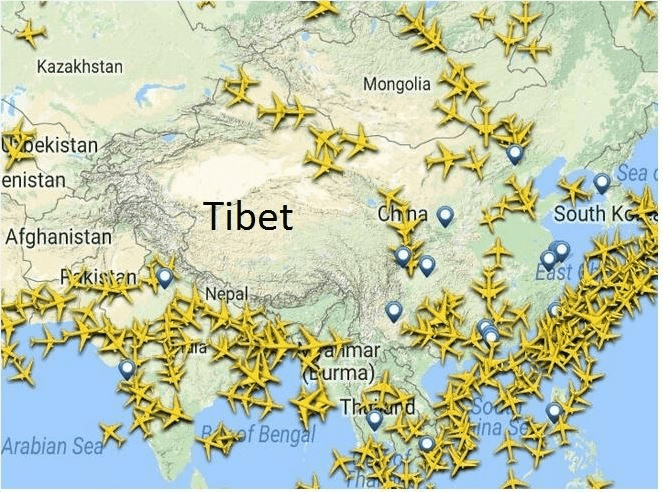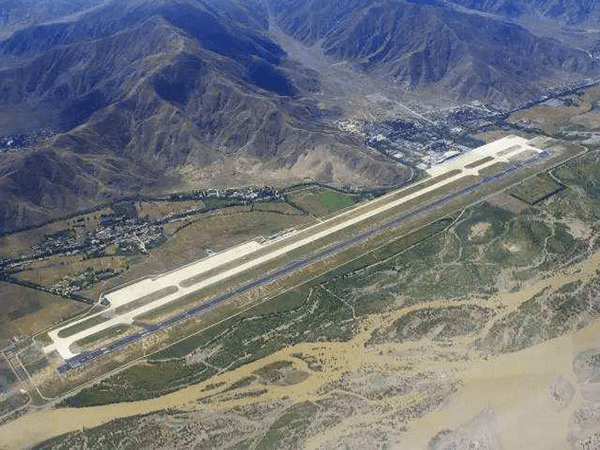Why Don’t Planes Fly Over Tibet?
Md. Nymuzzaman Saikat-
The Tibetan plateau is the least habitable and least populated region in the entire world after Antarctica and Greenland. It is the world’s highest geographical region and has the well-deserved nickname “the roof of the world” due to the plateau’s average elevation of almost 4,500 meters or 14,764 feet above sea level.
Tibet has a long history of being seen as the last refuge of mystery, the secret, locked place where ancient mysteries that were lost to the rest of the Orient still exist. Though most of the mysteries are godly, there are some which can be explained like why airlines do not fly over Tibet.
According to some myths, an invisible force or a ghostly presence prevents airplanes from moving ahead from a specific location at such a high altitude. Leaving this aside, let us explore the motivations behind the subject.

The first effort at aviation travel over this area was made mostly after World War II. British India needed to airlift supplies into China to help them fight the Japanese, and the journey from eastern India to Kunming was not particularly far – it was only 840 kilometers long. However, the pilots encountered exceptionally intense turbulence as they were passing over the isolated highlands and high peaks of the Tibetan plateau. wind gusts of up to 200 miles per hour and temperatures low enough to cause fuel to freeze. In addition, there were no emergency landing points in that region. Over a span of 42 months only, this dangerous flight path claimed the loss of 594 planes and 1,659 human lives.
Since then, Tibet has been opened for airlines through the opening of 5 airports including 1 international airport in Lhasa, which opened in 1966. There have been flights operating from and to Tibet. Yet almost every international flight between Eastern Asia and the west avoids flying over this region. Why?
Drift Down Difficulty in Emergency Situations:
The lofty typical stature of the Tibetan landscape serves as the primary justification for the airplane keeping a safe distance from the area. Of course, aircraft travel at considerably higher altitudes (typically 30,000 feet) than Tibet’s elevation level, which is more than 14,000 feet. But in the event of an emergency, such as cabin depressurization or engine failure, the recommended course of action is to descend below 10,000 feet before (known as Drift Down Procedure) turning around and landing at an airport.
Since most aircraft only give passengers 20 minutes of oxygen during cabin decompression, this is a serious problem. In Tibet, descending to 10,000 feet is regarded as suicide. Surprisingly, only Cathay Pacific has created viable escape routes across Tibet.
Clear Air Turbulence:
Unseen turbulence known as clear air turbulence is frequently linked to jet streams or unstable air pockets. Eddies are created by the mountain’s interference with the wind, and they can be extremely turbulent if you fly through them. Only other aircraft’s experience can be used to predict clear air turbulence, which is uncommon over the Tibetan Plateau.
Difficulty in Emergency Landing:
The Tibetan Plateau is a bad location for an emergency landing because these landings usually take place on flat, level ground. There are almost no flat surfaces in this region. Though Tibet has five airports, only light aircraft and specialized pilots may safely land on these due to their dangerously short runways. These airports are also situated on the periphery of higher mountain ranges, which simply amplifies the risk factors.

Challenging to Reach Wreckage and Rescue Survivors:
The area’s mountainous terrain makes rescue efforts particularly challenging. It is challenging to dispatch emergency crews to Tibet even if several passengers survive a plane disaster. The possibility of passengers successfully surviving on their own is also decreased by the harsh environment of the area. Even finding out what caused the jet crash may become impossible as the black box may potentially be tossed hundreds of meters away during a plane crash.
Besides Tibet, there are few other no-flying zones around the world due to various reasons like religious significance (Mecca, Saudi Arabia), environmental significance (Machu Picchu, Peru), historical significance (Parthenon, Greece), political significance (Downing Street, Buckingham Palace, and Windsor Castle, UK), and so on.
Md. Nymuzzaman Saikat is a student of Civil Engineering at the University of Asia Pacific, Dhaka



